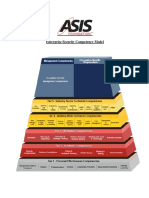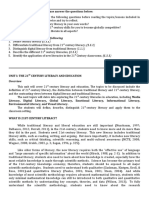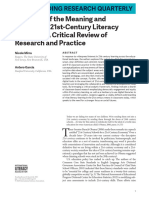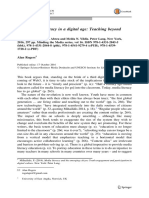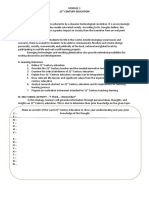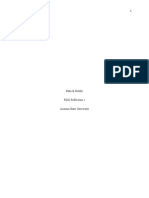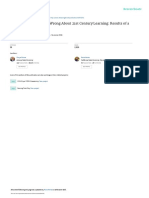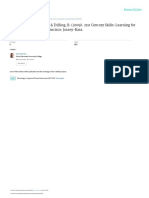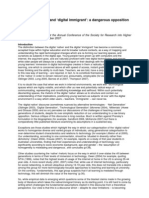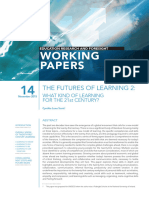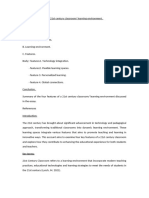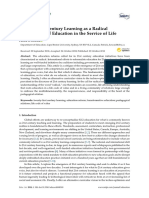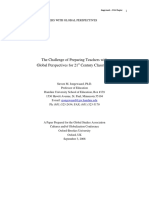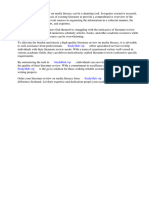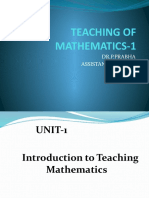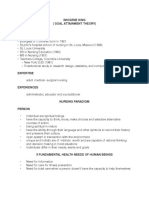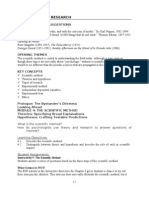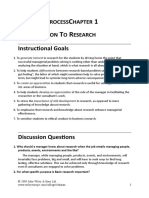What Knowledge Is of Most Worth: Teacher Knowledge For 21 Century Learning
What Knowledge Is of Most Worth: Teacher Knowledge For 21 Century Learning
Uploaded by
Arun D PaulCopyright:
Available Formats
What Knowledge Is of Most Worth: Teacher Knowledge For 21 Century Learning
What Knowledge Is of Most Worth: Teacher Knowledge For 21 Century Learning
Uploaded by
Arun D PaulOriginal Title
Copyright
Available Formats
Share this document
Did you find this document useful?
Is this content inappropriate?
Copyright:
Available Formats
What Knowledge Is of Most Worth: Teacher Knowledge For 21 Century Learning
What Knowledge Is of Most Worth: Teacher Knowledge For 21 Century Learning
Uploaded by
Arun D PaulCopyright:
Available Formats
What Knowledge Is of Most Worth:
Teacher Knowledge for 21st Century Learning
Kristen Kereluik
Punya Mishra
Chris Fahnoe
Laura Terry
Michigan State University
Abstract
This article offers a critical review of
the literature on 21st century knowledge frameworks, with a particular
focus on what this means for teachers
and teacher educators. The authors accomplish this by identifying common
themes and knowledge domains in 15
reports, books, and articles that describe the kinds of knowledge that researchers state are integral and important for success in the 21st century. The
authors argue that seemingly disparate
frameworks converge on three types
of knowledge, as necessary for the 21st
century: foundational, meta, and humanistic. Although 21st century frameworks are thought to advocate new
types of knowledge, little has actually
changed in the new century with respect to the overall goals of education.
Despite this sense of continuity, significant changes related to how technologies change all three types of knowledge
need to be conveyed. The article ends
with specific conclusions and recommendations for teacher education.
(Keywords: 21st century skills, Common Core, teacher eduction, TPACK)
Everything changes and nothing
remains still ... and you cannot
step twice into the same stream.
Heraclitus
Plus a change, plus cest la
mme chose.
The more things change, the more
they stay the same.
Jean-Baptiste Alphonse Karr
he issue of what our students need
to know has been receiving a great
deal of recent attentionmostly
under the auspices of 21st century learning. There is a feeling of distinct disjuncture between centuries past and the one
into which we are now emerging, and
that the educational demands of this
new century require new ways of thinking and learning (Gardner, 2008; Pink,
2005). As teacher educators, we are particularly sensitive to what 21st century
learning means in terms of the knowledge teachers must possess and how to
best facilitate that knowledge. Consider
for instance a report on the 21stcenturyschools.com website suggesting that
todays students, due to their immersion
in technology, are fundamentally different from students in the pastand thus
by implication have different learning
goals and necessitate different teaching
approaches:
Youve got a cell phone at one
ear and an iPod at the other. You
know that Blackberry is now a
verb and that Spam is not just
canned meat. Its the 21st century. Todays students, digital
natives, were born into a mediasaturated world, and their lives are
immersed in technologies from
cell phones, iPods, handheld gaming devices, PDAs, and laptops
they take everywhere, to the computers, TVs, and game consoles at
home. (21st Century Schools, n.d.)
So what is 21st century education?
It is bold. It breaks the mold. It
is flexible, creative, challenging, and complex. It addresses a
rapidly changing world filled with
fantastic new problems as well as
exciting new possibilities. (21st
Century Schools, n.d.)
Statements such as these are quite
common these days and have driven a
spate of books and reports that criticize the current goals and practices of
schooling (Keengwe, Onchwari, &
Wachira, 2008; Kozma, 2003; Zhao,
2009). These authors and groups suggest that current schooling practices
are designed to prepare citizens for the
industrial age rather than the needs and
demands of the new millennium (Robinson, 2001). Parallel to this are individuals and groups who offer a range of
suggestions for what are broadly labeled
21st century skills.
It is unclear what precisely phrases
such as 21st century knowledge, 21st century skills, and 21st century learning mean.
In some sense, 21st century becomes an
empty signifier (Barthes, 1977), a term
that we all think we understand yet are
hard pressed to clearly define. Do the
proposed frames or definitions have anything in common, or are they quite different from each other? How are these 21st
century knowledge frameworks different
from the overarching goals of education
that have been espoused in the past?
Critics of this new 21st centuryoriented
discourse argue that this emphasis on the
demands of a new century is just another
form of chronocentrism, the egotism
that ones own generation is poised on
the very cusp of history (Wikipedia,
2010). Are the proponents of 21st century
learning committing chronocentrism and
subsequent errors by basing their vision
of learning for the 21st century on the
tools and technologies available in the
Volume 29 Number 4 | Journal of Digital Learning in Teacher Education | 127
Copyright 2013, ISTE (International Society for Technology in Education), 800.336.5191 (U.S. & Canada) or 541.302.3777 (Intl), iste@iste.org, iste.org. All rights reserved.
Kereluik, Mishra, Fahnoe, & Terry
first decade of this century (Mishra &
the Deep-Play Research Group, 2012)?
Debates of this nature are not new;
they have been part and parcel of educational discourse for a long time. For
instance, more than 150 years ago, Herbert Spencer wrote an essay titled What
Knowledge Is of Most Worth, in which
he engaged in exactly this discussion,
except from the point of view of the late
19th and early 20th centuries (Spencer,
1884). Spencer bemoaned the fact that
most of the discussion around what is
worth knowing in his day and age was
based not on any rational discussion of
the issues, benefits, and costs of learning
one thing versus the other, but rather
was driven by instincts and personal
predilections. As he said:
Men (sic) read books on this topic,
and attend lectures on that; decide
that their children shall be instructed in these branches of knowledge,
and shall not be instructed in those;
and all under the guidance of mere
custom, or liking, or prejudice;
without ever considering the enormous importance of determining
in some rational way what things
are really most worth learning. It
is true that in all circles we hear
occasional remarks on the importance of this or the other order
of information. But whether the
degree of its importance justifies
the expenditure of the time needed
to acquire it; and whether there are
not things of more importance to
which such time might be better devoted; are queries which, if
raised at all, are disposed of quite
summarily, according to personal
predilections. (p. 3)
Reading Spencers words today gives
one a distinct sense of dj vu. There is a
tension between proponents and critics
of 21st century knowledge frameworks in
which one side sees epic shifts in necessary student knowledge and the other
sees only new branding of old ideas.
This article offers a critical review of
the literature on 21st century knowledge
frameworks, with a particular focus on
what this means for teachers and teacher
128
educators. The article begins by addressing the common call for 21st century
knowledge frameworks in both popular
culture and academia, followed by the
contexts and purposes for choosing 15
key documents for further qualitative
analysis. Next, the article explains the
coding and analysis process leading to
the development of a set of overarching
categories to offer a coherent integrative
framework that would help anchor our
understanding of 21st century knowledge. Finally, the article concludes by
discussing implications of this new
emergent framework for educators.
21st Century Knowledge Frameworks
The call for 21st century knowledge
frameworks largely rests on the assertion that education has failed to prepare
students for the demands of the 21st
century. Schooling (in terms of organization, structure, and format) remains
much the same today as it was throughout the 20th century. The recommendations around 21st century knowledge
emerged from educators such as Howard
Gardner (Gardner, 2008), popular writers such as Daniel Pink (Pink, 2005),
and organizations such the Partnership
for 21st Century Skills (Partnership for
21st Century Skills, 2007) and the Center
for Public Education (Jerald, 2009).
These individuals and organizations
argued that it had become increasingly
evident that the labor force required
by an increasingly globalized economy
requires an altogether different model of
educationone that transcends the 20th
century skills of repetition, basic applied
knowledge, and limited literacy.
With this in mind, we set out to
understand and define what 21st century
learning, according to those involved
in the discussion, actually means. This
work is critically important because it
will aid in determining what and, just as
important, how we teach our students
and in turn how we train and prepare
teachers to do this.
Numerous institutions, organizations,
and individuals responded to the call
for a 21st century knowledge framework
by identifying the student knowledge
necessary for living and learning in the
21st century (as mentioned above), and
searches on Google lead to millions (if
not more) of websites and pages devoted
to these terms. Upon review, there is
quite a bit of diversity in the content of
the responses from these organizations.
If you looked at the popular press, for
instance, you would read that 21st century learning appears to be inordinately
focused on technological tools, such
as wikis and blogs, or mobile learning
(21stcenturyschools.com, 2010). The assumption appeared to be that these tools
embed within themselves clear ways of
thinking about content and pedagogy
that conform to the needs of developing
21st century knowledge.
We were, however, somewhat
skeptical of these claims. First, research
shows that specific technologies do not
demand specific ways of teaching and
structuring content (Mishra & Koehler,
2006). One could use a wiki in a collaborative manner as easily as one could
use a repository of instructor slides.
This does not imply that technologies do
not have specific strengths and weaknesses, but rather that technologies do
not determine completely how they are
to be used. Instead of predetermined
outcomes, technologies provide us
with a zone of possibility (Dirkin,
2009; Dirkin & Mishra, 2010; Mishra &
Kereluik, 2011). Second, given the rapid
pace of technological change, it seems
shortsighted to base the education of the
entire 21st century on the tools available
today! Third, we found that much of this
discussion appeared to emphasize creativity, innovation, and collaboration but
provided (at least on a cursory level) less
attention to content (disciplinary knowledge), though it was clear to us that a
highly technologically developed society
would need deep levels of knowledge of
the disciplines. Given these concerns, we
deemed the specific pursuit of common
themes and ideas across different frameworks and approaches a worthy goal for
this research project.
Clearly, inclusion of every piece of
writing devoted to 21st century learning
(particularly in this age of Google) was
impossible, so instead we shifted our
focus to independent, high-visibility
| Journal of Digital Learning in Teacher Education | Volume 29 Number 4
Copyright 2013, ISTE (International Society for Technology in Education), 800.336.5191 (U.S. & Canada) or 541.302.3777 (Intl), iste@iste.org, iste.org. All rights reserved.
Teacher Knowledge for 21st Century Living
frameworks across education and economic organizations. The final list of
15 frameworks includes reports from
educational organizations such as the
American Association of Colleges and
Universities, the Educational Testing
Service, the Center for Public Education,
the International Society for Technology
in Education, WestEd, The Partnership
for 21st Century Skills, the MacArthur
Foundation, Center for Public Education, the National Academy of Engineering; corporations such as Cisco, Microsoft, and Intel; international bodies
such as the European Union; business
interests such as the Organization for
Economic Cooperation and Development & the Metiri Group; individual
scholars such as Howard Gardner and
Yong Zhao; and popular writers such as
Daniel Pink. These 15 reports, frameworks, and books offer somewhat different perspectives on what is meant by
21st century knowledge/skills/learning and
thus offer a somewhat comprehensive
overview of this field. A complete, annotated list of the documents we selected
for further analysis can be found in Appendix A (pp. 135138).
We looked across frameworks with
one primary goal in mind: to identify common recommendations and
elements of 21st century frameworks
in order to understand what types of
knowledge are claimed to be integral to
a 21st century approach.1
One thing became quite clear even
through a first reading of these various
documents: The various frameworks
offered two main justifications for the
need to rethink the kinds of knowledge
required for learning in this century
technological modernization and globalization. Technological modernization
includes the economic shift in developed
countries from manual and routine jobs
to an intellectual and knowledge economy, and the diffusion of technology from
strictly the workplace into all aspects of
personal and professional life. Globalization includes the breakdown of national
economic and social boundaries and the
introduction of a newly interconnected
and diverse global society, facilitated and
accelerated by technological modernization. Given these two powerful forces
driving a new millennium of education,
this work seeks to elucidate each frameworks conceptualization of what knowledge is necessary for the 21st century.
Methodology
In the next part of the study, we focused
on a more detailed and systematic analysis of what the 15 frameworks recommended by coding individual elements
of each of the different frameworks. We
analyzed relevant documents to recognize patterns and themes that emerged
from the data. As Anafara et. al. (2002)
have suggested, this form of analysis
brings meaning, structure, and order
to data and thus allows the researcher
to categorize it in meaningful ways. The
ultimate goal of analysis was to develop
a synthesis that captured the essential
elements of all 15 frameworks.
To make sense of the complex and
diffuse textual data at hand, it was
necessary to horizontalize the data. In
doing so, we broke the frameworks into
individual elements, which served as the
unit of analysis during coding. We accomplished this horizontalization of the
data using the traditional cutting and
sorting technique (Ryan & Bernard,
2003), where we read the 15 manuscripts
carefully and typed out the essential
elements of each of these frameworks
on a separate sheet, printing the coded
identification of the origin of the element along with the element so that we
could identify where the text came from.
We then spread these elements out,
read them, and sorted them into natural
clusters. We paid close attention to word
repetitions and synonyms as well as the
occurrence of keywords in context of the
phrases or sentences in which they occurred. We then reviewed these individual pieces and re-categorized them with
an eye for emergent themes. The first
two authors also engaged in a process of
constant comparison: As they placed
each element in a group or category,
they compared it to all the other ele-
ments that were already in the category
(Glasser, 1965). They did this to ensure
that the categorization was consistent,
and they reconsidered and recategorized
elements that did not fit. The first two
authors engaged in this continuous iterative process until there were no elements
that did not fit in specific categories.
We then arranged the indigenous
categories hierarchically (i.e., via a
branching arrangement of categories
and subcategories). The titles of these
categories (and subcategories) emerged
from the newly reorganized clusters.
The Synthesis:
The Framework of Frameworks
The analysis and review led to the
identification of three broad categories
with three subcategories within them.
The three broad categories are Foundational Knowledge, Meta Knowledge, and
Humanistic Knowledge. Each category
and subcategory is comprised of references from several, and in most cases
a vast majority, of the frameworks. For
example, the category Foundational
Knowledge emerged from subcategories
such as Core Content Knowledge. Core
Content Knowledge emerged from distinct references from the Metiri Group
(2003) (high academic standards), European Union (2006) (mathematical and
scientific competence), Partnership for
21st Skills (2007) (core subjects), American Association of Colleges and Universities (2007) (quantitative literacy),
Howard Gardner (2008) (disciplined
mind), Center for Public Education
(Jerald, 2009) (advanced knowledge in
traditional subjects), and Assessment
and Teaching of 21st Century Skills
(2012) (core curriculum). Similarly,
Meta Knowledge emerged from subcategories such as Creativity and Innovation. Creativity and Innovation emerged
from references from the Metiri Group
(2003) (inventive thinking), European
Union (2006) (creativity), ISTE (2007)
(creativity and innovation), Yong Zhao
(2009) (creativity), Partnership for
21st Century Skills (2007) (creativity),
American Association of Colleges and
1
We excluded frameworks that overlapped significantly with a framework we had already selected. For instance, we excluded the National Assessment of Educational Progress and Technological Literacy Framework for the
2012 National Assessment of Educational Progress in the interest of parsimony.
Volume 29 Number 4 | Journal of Digital Learning in Teacher Education | 129
Copyright 2013, ISTE (International Society for Technology in Education), 800.336.5191 (U.S. & Canada) or 541.302.3777 (Intl), iste@iste.org, iste.org. All rights reserved.
Kereluik, Mishra, Fahnoe, & Terry
Universities (2007) (creativity and critical thinking), Howard Gardner (2008)
(creating mind), Daniel Pink (2005)
(play, design), and many more. Finally,
Humanistic Knowledge was similarly
constructed out of subcategories such
as Ethical and Emotional Awareness,
based on references from the American
Association of Colleges and Universities
(2007) (ethical reasoning), Daniel Pink
(2005) (empathy), Howard Gardner
(2008) (ethical mind, respectful mind),
European Union (2006) (management
of feelings, emotional intelligence), Yong
Zhao (2009) (emotional intelligence),
and the European Union (2006) (high
ethical standards).
Each category represented a different realm of knowledge, as Figure 1
demonstrates. Each of these overarching categories and subcategories are
described in greater detail below. Please
note that Appendix B (pp. 138140)
gives the actual breakup of the elements
of each of the frameworks across these
categories.
Foundational Knowledge
This category is the answer to the what
question (i.e., What do students need to
know?). The frameworks reviewed saw
this in terms of three key subcategories:
Core Content Knowledge, Digital Literacy, and Cross-Disciplinary Knowledge.
Core Content Knowledge. Core
content knowledge and disciplined
ways of thinking are characterized by
highly complex and deeply ingrained
mental processes specific to traditional
domains, such as applying mathematical ways of thinking to solve everyday
problems or applying scientific ways of
thinking to understanding the natural
world (Gardner, 2008). From the data
we gathered, core content knowledge
and high academic achievement in traditional domains appeared to be among
the most frequently cited essential skills
for success in the 21st century (a complete list is provided in Appendix B,
pp. 138140). Excellence in traditional
academic domains such as English and
mathematics were considered to be the
foundations upon which other 21st century skills are to be developed.
130
Figure 1. Synthesis of 15 different 21st century learning frameworks into one visual image.
Digital & Information Literacy. Digital
and information literacy, like core content
knowledge, was often cited as a skill
necessary for success in the 21st century. It
can be defined as the ability to effectively
and thoughtfully evaluate, navigate, and
construct information using a range of
digital technologies and thus to function
fluently in a digital world. An important
part of this is the ability to effectively
seek out, organize, and process information from a variety of media. This form
of literacy also includes a component of
responsible use of technology and media,
an important moral and ethical consideration beyond understanding basic information and communication technology
systems and media forms.
Cross-Disciplinary Knowledge. Crossdisciplinary knowledge is knowledge
that integrates and synthesizes information from across fields or domains, such
as the application of knowledge to new
contexts in the pursuit of specific end
goals. Synthesis can be related to both
constructing meaning (i.e., making
sense of different domains and their relationships) and to the generation of new
ideas (i.e., trans-disciplinary creativity).
The developers of the frameworks often
asserted that this type of knowledge is
crucial to success in the 21st century, as
it also involves the ability to understand,
organize, and connect the vast amounts
of information now available with the
advent of digital media.
Meta Knowledge
This category was about knowledge of
the process of working with foundational knowledge. This could also be seen in
terms of three subcategories: Problem
Solving & Critical Thinking, Communication & Collaboration, and Creativity &
Innovation.
Problem Solving & Critical Thinking.
Critical thinking frequently involves
the ability to interpret information
and make informed decisions based
on such information. Problem solving
is often conceptualized as the use of
critical thinking skills toward the effective resolution of a specific problem
or toward a specific end goal. Problem
solving and critical thinking most often
involve the cognitive skills necessary
for success in emerging economic and
social domains.
Communication & Collaboration. Communication most frequently involves
the ability to clearly articulate oneself
through all media of communication
oral, written, nonverbal, and digitalas
well as the skills necessary to be an active
and respectful listener to diverse audiences. Collaboration includes similar dimensions as communication but also includes
important individual contributions, such
as flexibility, willingness to participate,
and recognition of group and individual
efforts and success. Communication and
collaboration are cited as essential to success in the 21st century as working with
| Journal of Digital Learning in Teacher Education | Volume 29 Number 4
Copyright 2013, ISTE (International Society for Technology in Education), 800.336.5191 (U.S. & Canada) or 541.302.3777 (Intl), iste@iste.org, iste.org. All rights reserved.
Teacher Knowledge for 21st Century Living
diverse groups becomes of the utmost
importance in our increasingly globalized culture and economy.
Creativity & Innovation. Creativity was
one of the skills that was most cited as
necessary for success in the 21st century.
Creativity and innovation involve applying a wide range of knowledge and
skills to the generation of novel and
worthwhile products (tangible or intangible) as well as the ability to evaluate,
elaborate, and refine ideas and products. It is often reasoned that the highly
complex problems facing society in the
21st century necessitate new and creative
solutions.
Ethical & Emotional Awareness. Ethical awareness included the knowledge
and skills necessary for success in a culturally diverse society, such as the ability
to imagine oneself in someone elses
position and feel with that individual as
well as the ability to engage in ethical
decision making. It also includes the
ability to intuit the feelings of others, a
skill thought to be crucial for success in
the 21st century, when success in social
and economic realms necessitates a deep
understanding of human emotions and
successful human interactions.
Humanistic Knowledge
A humanistic theme emerged through
the analysis of the various frameworks.
This form of knowledge offers a vision
of the learners self and its location in a
broader social and global context. The
three main subcategories that emerged
under this broader rubric are: Life/Job
Skills/Leadership, Cultural Competence,
and Ethical/Emotional Awareness.
Life Skills, Job Skills, & Leadership.
Life skills, job skills, and leadership (including aspects of personal and professional leadership) serve to create lifelong
learners who are capable of success
beyond the confines of the classroom.
Job and life skills were most often cited
around three realms: those that serve to
effectively manage and organize ones
efforts, those that serve to coordinate
and organize relevant and important
information, and those that serve in the
development of end products (tangible
and intangible) in the pursuit of the
resolution of specific solutions to relevant problems (European Union, 2006;
Jenkins, 2006; Zhao, 2009).
Cultural Competence. Cultural competence also includes aspects of personal,
interpersonal, and intercultural competence evidenced through effective communication, collaboration, and appreciation of ideas and emotions of all types of
individuals. Cultural competence, like
ethical awareness, is thought to be essential for social and economic success in
the 21st century as a result of increased
cultural diversity from globalization.
Broad Implications
The review of 15 of the most significant
21st century knowledge frameworks has
led to new conclusions and a new categorization of three overarching categories with three corresponding subcategories. Each of these major categories can
be seen as what we need to know, how
we act on that knowledge, and the values
we bring to our knowledge and action.
It is important to note that while three
realms of knowledge emerged from the
initial nine subcategories, many of the
subcategories overlap both in terms of
their novel significance and the avenues
through which they achieved this newly
significant status. The realms function
not as discrete categories of knowledge
but as complimentary categories that
support and inform one another. It is
also important to note that we did not
construct these categories, but rather
they emerged from the analysis of these
15 documents. The final and important
issue to point out is that knowledge
of technology was evident in just one
subcategory, Digital and Information
Literacy. This is in sharp contrast to
most rhetoric that we typically hear in
the popular media (as evidenced by
the quote on 21st century learners that
started the chapter).
Two key contributions emerged from
this review. We argue that our analysis
indicates a somewhat paradoxical state of
affairs when we think about 21st century
knowledge. First, we argue that our synthesis of these different frameworks sug-
Discussion
gests that nothing has changed, that this
tripartite division between what we know,
how we act on that knowledge, and what
we value has always been important. That
said, though these foundational ideas
have always been key to learning, in some
vital ways (particularly given advances in
technology and globalization), everything has changed. Taking each of these
positions in turn, we explain them more
comprehensively below.
Nothing has changed. It is clear that
not all of the knowledge and skills
present in 21st century frameworks are
unique and novel to this century. This
idea is not unique to our analysis; Diane
Ravitch seems to share this sentiment:
There is nothing new in the proposals
of the 21st century skills movement. The
same ideas were iterated and reiterated
by pedagogues across the twentieth
century (2009). The world of the future
will continue to depend on specialized
knowledge (or domain knowledge)
and high-level cognitive skills (such as
creativity and critical thinking). These
skills, rather than being novel to the
21st century, are required for successful learning and achievement in any
time, including but not limited to the
21st century. Additionally, interpersonal
skills (such as life skills, leadership, and
cultural competence) have also been
important in the past and will continue
to be in the future.
Everything has changed. For a variety
of reasons, though core ideas and goals
of education have not changed, the specifics of how each of these is instantiated
have changed (Jerald, 2009; Keengwe,
Onchwari, & Wachira, 2008; Metiri
Group, 2003). Although this may seem
contradictory to the previous statement
that nothing has changed, it remains
true and highlights the complex and
even sometimes ambiguous impact of
technology and globalization on teaching and learning.
Changes to foundational knowledge.
Technology in the foundational realm
asserts itself as something to know.
Information literacy, while not unique
to the 21st century, is uniquely pressing in the 21st century. Clearly multiple
forms of media existed prior to the dawn
Volume 29 Number 4 | Journal of Digital Learning in Teacher Education | 131
Copyright 2013, ISTE (International Society for Technology in Education), 800.336.5191 (U.S. & Canada) or 541.302.3777 (Intl), iste@iste.org, iste.org. All rights reserved.
Kereluik, Mishra, Fahnoe, & Terry
of the 21st century; however, the social,
economic, and informational impact of
the Internet and digital media is unprecedented. The Internet and digital media
represent a new realm of interaction of
which successful navigation is essential
for success in the 21st century, and once
gathered and comprehended, new skills
and knowledge are necessary to collaborate digitally and contribute to the
collective knowledge base.
The effect of technology on foundational knowledge in the 21st century
goes well beyond the obvious dimension of digital and information literacy.
Content has also been altered with the
rapid advancement of technology in
the 21st century in terms of both access
to information and how information is
represented (Summers, 2012, p. ED26).
Individuals now have nearly instant access to information on an unprecedented scale, and the advent of easy-to-use
software has lowered the barrier of entry
to many activities. For example, online
music simulators (e.g., Audacity, Open
Orchestra) make it possible for students
to learn about and experience music in
new ways that, although possible previous to the 21st century, had much more
significant barriers of entry, including
necessary prerequisite knowledge and
access to equipment.
More important, the nature of
disciplinary knowledge itself and the
methods for acquiring it have changed
significantly due to the advent of the
digital computer. The introduction of
digital technologies has changed the
methods and techniques of acquiring,
representing, and manipulating knowledge in almost all disciplines, from
mathematics to music, astronomy, and
archeology. It is clear that the education
of the next generation of citizens needs
to change to keep up with these developments (Mishra, Terry, Henriksen, & the
Deep-Play Research Group, 2013).
Finally, most of the progress in the
recent past has been in areas that cut
across traditional disciplinary boundaries (Mishra, Koehler, & Henriksen,
2011; Mishra & the Deep-Play Research
Group, 2012), caused in large measure by the protean nature of digital
132
technologies (Koehler & Mishra, 2008).
From bio-technologists to computational political scientists, from experts in
data-mining who seek patterns in user
behavior on the Web to programmerartists who create scientific simulations
to represent complex multidimensional
phenomena, the world of the future depends on people who have deep knowledge of more than one discipline and the
ability to see connections between these
disciplines. Thus, cross-disciplinary
knowledge and the ability to synthesize
information are ultimately different in
the 21st century than in the past, and
an ever-expanding amount of information necessitates the ability to synthesize
information and derive meaning.
Changes to meta knowledge. Technology in the meta realm asserts itself
as knowledge to act with foundational knowledge and technology. This
includes the ability not only to use
technology in basic, predetermined (by
the designer) ways, but to reuse and
repurpose technology to meet specific
educational needs and teaching/learning goals. Problem solving and critical
thinking are not unique to the 21st century. However, they are transformed by
technology as the unprecedented access
to vast amount of information available
on the Internet place a greater burden
on individuals accessing information, as
they must now possess the ability to discern, beyond simple aesthetics, between
high-quality information and information of questionable quality.
Technology also changes communication and collaboration in crucial ways.
The need to effectively communicate
and collaborate is not novel, but ease of
access has made large-scale communication and collaboration across thousands
of miles commonplace. With increased
globalization and affordances of new
technology, individuals from diverse cultures are exposed to one another on an
unprecedented level, and successful collaborationand consequently cultural
competenceis essential (Jerald, 2009).
Communication and collaboration serve
as an effective bridge between meta
knowledge and humanistic knowledge
as cultural competence (a subcategory
of humanistic knowledge) aids in, and is
necessary for, successful communication
and collaboration in the 21st century.
Changes to humanistic knowledge.
Technology in the humanistic realm
asserts itself as something to value
both in others and in the possibilities
of technology. Humanistic knowledge,
while seemingly the most distant from
the effects of technology, has nonetheless been modified by technology in the
21st century in that the ability to regulate
ones efforts has become a multifaceted
effort that necessitates organization of
ones demands in different realms of life
(personal, professional) to successful
ends. In fact, self-regulation is becoming an important skill for students to
learn (Mishra, Fahnoe, Henriksen, & the
Deep-Play Research Group, 2013). Ethical and moral questions abound, many
in arenas that had not typically been
areas of doubt or discussion. Whether
we consider issues of privacy and intellectual property or bio-technology and
stem-cell research, individuals today
(and in the future) have to develop
fine-tuned ethical and moral modes
of thought and action. All of this is, of
course, exacerbated by the ability to
easily and efficiently communicate with
diverse groups of individuals across the
world. Ethical and emotional awareness,
while not novel to the 21st century, are
uniquely important when working with
diverse groups of individuals. The issue
of humanistic knowledge becomes even
more critical in an increasingly globalized and interconnected world, where
different cultures have to meet and interact (Jerald, 2009). In contexts like this,
developing a value system that respects
differences and yet maintains a core of
empathy and understanding becomes
critically important.
Implications for Teachers
and Teacher Educators
This framework provides some specific
recommendations for teachers and
teacher educators. In brief, we point to
three key suggestions.
First, disciplinary knowledge and
domain knowledge are as important
as ever and will continue to be so well
| Journal of Digital Learning in Teacher Education | Volume 29 Number 4
Copyright 2013, ISTE (International Society for Technology in Education), 800.336.5191 (U.S. & Canada) or 541.302.3777 (Intl), iste@iste.org, iste.org. All rights reserved.
Teacher Knowledge for 21st Century Living
into the foreseeable future. Educational
systems remain fundamentally based
on disciplinary knowledge and, as such,
require teachers to be adequately trained
and proficient in the disciplines. The
advancement of the Common Core State
Standards not only maintains a focus
on disciplinary knowledge, but also
appreciates the importance of students
as critical thinkers with the ability to
analyze information in the execution
of daily tasks (NGA Center, 2010).
The need for students to develop deep
disciplinary knowledge has always been
important; what has changed is access
to disciplinary knowledge and authentic disciplinary inquiry made available
through technology and subsequently
experts and resources. Although some
may argue that there is a divide between those promoting these types of
21st century skills and the structure of
the Common Core State Standards,
meaningful alignments exist between
the two. For example, the 4 Cs (critical
thinking and problem-solving, creativity
and innovation, communication, and
collaboration) are represented throughout the standards. Students and teachers must work in purposeful learning
communities, engage with questions that
require reflection, defend conclusions,
and problem-solve like detectives while
responding like investigative reporters.
Therefore, the current base of disciplinary knowledge that the Common Core
expresses encompasses both traditional
content knowledge and concepts forwarded in modern frameworks, such as
students having strong communication
skills integrated across content areas, being metacognitive in an iterative process,
engaging with complex texts and complex problem solving, and developing a
world focus.
Second, knowing the technology
is important, but knowing when and
why to use it is more important. This is
closely related to the TPACK framework
and knowledge that teachers must possess to teach effectively with technology
(Mishra & Koehler, 2006). However, it
is distinctly different in that the TPACK
framework is admittedly content neutral
and pedagogically neutral. In sharp
contrast, this framework identifies and
places great emphasis on the foundational knowledge that students and
teachers must possess. That being said,
basic digital literacy skills are essential
for both students and teachers. Knowing
when to use a particular technology for
activities such as collaboration, or why
to use a certain technology for acquiring specific disciplinary knowledge, is a
vastly more important, transferable, infinitely relevant type of knowledge, one
that will not quickly become antiquated
with ever-changing technological trends.
Third, technological advances of
the 21st century have brought us closer
together and at the same time further
apart. Advances to technology and infrastructure have made physical proximity
optional, not only in education, but also
in fields such as business and medicine,
and they have made availability for
interaction effortless. As a result of the
increased opportunity for interaction
across countries and around the world,
teachers need to know how to foster cultural competence, emotional awareness,
and leadership skills to facilitate not just
interactions, but meaningful interactions and relationships. Interestingly,
this specific type of knowledge is largely
absent of the standards-based movements in education and not always seen
as worthy of prolonged instructional
time and effort.
Conclusion
We see this analysis as a significant contribution to the discussion on 21st century
skills. Our emergent categorization
scheme gives us a big picture of what
we mean when we say 21st century learning. Clearly the demarcation between the
three categories (and the subcategories) is
not clear cut; there are overlaps between
them, but our emergent framework does
provide a clearer vision of a field that had
been dominated by multiple, seemingly
conflicting perspectives.
We began with the question of what
knowledge is of greatest worth at a time
of flux and change. The Greek philosopher Heraclitus argued that because
our reality is always changing, our
knowledge of the world is constantly
going out of date. As he famously said,
You cannot step into the same river
twice. This continual turmoil, argued
Heraclitus, implied that we can never
have true knowledge. We are faced with
a somewhat similar conundrum when
we speak of what knowledge is worth
having. The rapid changes we see in
the world around us brought about by
the forces of globalization and technological and cultural change often make
it difficult to gauge what exactly it is
that our students need to be learning
in schools and how teachers are to be
trained in order to prepare our students
for the future.
Our analysis indicates that this seeming
paradox of nothing has changed and everything has changed provides us a way
forward. It suggests that, though the 21st
century is different from previous times,
it does not mean that our core roles (to
know, to act, and to value) have changed.
So, in that sense, there is no disjuncture
between what we have been doing as educators in the past and what we do today
(and in the future). That being said, it also
indicates, even as we hold onto these core
ideas, that we have to continually shift and
come up with newer ways of instantiating
them. So, though the manner in which
we represent knowledge and act upon it
may change, the core idea of what we do as
educators has not.
Finally, we end by returning to Herbert Spencer (1884), who a century and
a half ago wrote:
If there requires further evidence of
the rude, undeveloped character of
our education, we have it in the fact
that the comparative worths of different kinds of knowledge have been
as yet scarcely even discussed
much less discussed in a methodic
way with definite results. Not only
is it that no standard of relative
values has yet been agreed upon; but
the existence of any such standard
has not been conceived in a clear
manner. And not only is it that the
existence of such a standard has not
been clearly conceived; but the need
for it seems to have been scarcely
even felt. (p. 147)
Volume 29 Number 4 | Journal of Digital Learning in Teacher Education | 133
Copyright 2013, ISTE (International Society for Technology in Education), 800.336.5191 (U.S. & Canada) or 541.302.3777 (Intl), iste@iste.org, iste.org. All rights reserved.
Kereluik, Mishra, Fahnoe, & Terry
Our true and sincere hope is that our
careful analysis and discussion of the
term 21st century learning is one way of
addressing the concerns of Spencer and
truly moving education into the future.
Editors Note
The authors presented an earlier version of this
research at the 2011 annual meeting of the Society
of Information Technology in Teacher Education in
Nashville, Tennessee, USA.
Author Notes
Kristen Kereluik is a researcher at the Michigan
Virtual Learning Research Institute at Michigan
Virtual University and pursuing her doctorate at
Michigan State University. Her current work focus
on research and policy around online teaching and
learning both within Michigan and nationally. Her
specific research focuses on preparing online K12
teachers and supporting online K12 students.
Please address correspondence regarding this article
to Kristen Kereluik, Michigan Virtual Learning
Research Institute, Michigan Virtual University,
3101 Technology Blvd., Suite G, Lansing, MI 48910.
E-mail: kereluik@msu.edu
Punya Mishra is a professor of educational psychology and educational technology at Michigan State
University, where he directs the Masters of Arts in
Educational Technology. His research has focused
on the technology integration in teaching, teacher
creativity and trans-disciplinary learning. Please
address correspondence regarding this article to
Dr. Punya Mishra, College of Education, Michigan
State University, Erickson Hall, 620 Farm Lane
- Room #509A, East Lansing, MI 48824-1034.
E-mail: punya@msu.edu
Christopher Fahnoe is currently a PhD candidate
at Michigan State University in the Educational
Psychology and Educational Technology (EPET)
program. In addition he currently serves as
the Director of Technology and Assessment for
Arlington Heights School District 25 (PK8) in
Arlington Heights, Illinois. His current research
interests include self-directed learning, the
response to failure and creativity, and the design
of technology-enhanced learning spaces. Please
address correspondence regarding this article to
Christopher Fahnoe, Director of Technology and
Assessment, Arlington Heights School District
25, 1200 S. Dunton Ave., Arlington Heights, IL
60005. E-mail: fahnoech@msu.edu
Laura Terry is a doctoral candidate in the Educational Psychology and Educational Technology Program at the College of Education at Michigan State
University. Her research interests include issues of
academic motivation for student-athletes as well as
factors affecting urban classroom teachers integration of technology. Please address correspondence
regarding this article to Laura Terry, College of
Education, Michigan State University, Erickson Hall,
620 Farm Lane, Room #509A, East Lansing, MI
48824-1034. E-mail: terrylau@msu.edu
134
References
21st Century Schools (n.d.). About us. Retrieved
from http://www.21stcenturyschools.com/
About.htm
21st Century Schools (n.d.). What is 21st century
education? Retrieved May 20,2013, from http://
www.21stcenturyschools.com/about.htm
American Association of Colleges and
Universities. (2007). College learning for the
new global century. Retrieved from http://www.
aacu.org/leap/documents/GlobalCentury_
final.pdf
Anfara, V. A., Brown, K. M., & Mangione, T. L.
(2002). Qualitative analysis on stage: Making
the research process more public. Educational
Researcher, 31(7), 2838.
Assessment and Teaching of 21st Century Skills
(2012). What are 21st century skills? Retrieved
from http://atc21s.org/
Barthes, R. (1977). Image-music-text. London:
Fontana.
Bernie, T., & Hood, P. (1999). Learning,
technology, and education reform in the
knowledge age, or Were wired, webbed, and
windowed, now what? Educational Technology,
39(3), 518.
Dirkin, K. H. (2009). Three professors teaching
online: The realization of teaching perspectives.
Dissertation Abstracts International: Section A.
The Humanities and Social Sciences, 69(10), 3917.
Dirkin, K. H., & Mishra, P. (2010). Values, beliefs,
and perspectives: Teaching online within the
zone of possibility created by technology. In D.
Gibson, & B. Dodge (Eds.), Proceedings of the
Society for Information Technology & Teacher
Education International Conference 2010 (pp.
38113817). Chesapeake, VA: AACE. Retrieved
from http://editlib.org/p/33974
Educational Testing Service, International ICT
Testing Panel. (2007) Digital transformation:
A framework for ICT literacy. Retrieved from
http://www.ets.org/Media/Tests/Information_
and_Communication_Technology_Literacy/
ictreport.pdf
Gardner, D., Larsen, Y. W., Baker, W. O., Campbell,
A., Crosby, E. A., Foster, C. A., et al. (1983). A
nation at risk: The imperative for educational
reform. An open letter to the American people.
A report to the nation and the secretary of
education. Washington, DC: Government
Printing Office. Retrieved from http://www.eric.
ed.gov/PDFS/ED226006.pdf
Gardner, H. (2008). Five minds for the future.
Boston, MA: Harvard Business Press.
Glasser, B. (1965) The constant comparative
method of qualitative analysis. Social Problems,
12(4), 436445.
Greenhill, V., & Petroff, S. (2010). 21st century
knowledge and skills in educator preparation.
Education (p. 30). Retrieved from http://www.
p21.org
Heckman, P. E., & Montera, V. L. (2009). School
reform: The flatworm in a flat world: From
entropy to renewal through indigenous
invention. Teachers College Record, 111,
13281351.
International Society for Technology in Education
(ISTE). (2007). The National Educational
Technology Standards and performance
indicators for students. Retrieved from http://
http://www.iste.org/standards.aspx
Jenkins, H., Clinton, K., Purushotma, R.,
Robinson, A. J., & Weigel, M. (2006).
Confronting the challenges of participatory
culture: Media education for the 21st century.
Chicago, IL: The MacArthur Foundation.
Jerald, C. D. (2009). Defining a 21st century
education. Retrieved from the Center for
Public Education website: http://www.
centerforpubliceducation.org/LearnAbout/21st-Century/Defining-a-21st-CenturyEducation-Full-Report-PDF.pdf
Keengwe, J., Onchwari, G., & Wachira, P. (2008).
The use of computer tools to support meaningful
learning. AACE Journal, 16(1), 7792.
Koehler, M. J., & Mishra, P. (2008). Introducing
TPACK. In J. A. Colbert, K. E. Boyd, K. A.
Clark, S. Guan, J. B. Harris, M. A. Kelly, & A.
D. Thompson (Eds.), Handbook of technological
pedagogical content knowledge for educators (pp.
128). New York: Routledge.
Kozma, R. (Ed.) (2003). Technology, innovation,
and educational change: A global perspective.
Eugene, OR: International Society for
Technology in Education.
Metiri Group. (2003). enGauge 21st century skills for
21st century learners. Retrieved from http://www.
metiri.com/21/Metiri-NCREL21stSkills.pdf
Mishra, P., & The Deep-Play Research Group
(2012). Rethinking technology & creativity
in the 21st century: Crayons are the future.
TechTrends, 56(5), 1316.
Mishra, P., Fahnoe, C., Henriksen, D., & the
Deep-Play Research Group (2013). Creativity,
self-directed learning, and the architecture of
technology rich environments. Tech Trends,
57(1), 1013.
Mishra, P., Henriksen, D., & The Deep-Play
Research Group (2012). On being (in)
disciplined. TechTrends, 56(6), 1821.
Mishra, P., & Kereluik, K. (2011). What 21st
century learning? A review and a synthesis. In
M. Koehler & P. Mishra (Eds.),Proceedings of
Society for Information Technology & Teacher
Education International Conference 2011(pp.
33013312). Chesapeake, VA: AACE.
Mishra, P., & Koehler, M. J. (2006).Technological Pedagogical Content Knowledge: A new framework for teacher
knowledge.Teachers College Record108(6),
10171054.
Mishra, P., Koehler, M. J., & Henriksen, D. (2011). The
seven trans-disciplinary habits of mind: Extending
the TPACK framework towards 21st century
learning. Educational Technology, 51(2) 2228.
Mishra, P., Terry, C., Henriksen, D., & the Deep-Play
Research Group (2013). Square peg, round hole,
good engineering. Tech Trends, 57(2), 2225.
National Academy of Engineering. (2004). The
engineer of 2020: Visions of engineering in the
new century. Washington, DC: The National
Academy Press.
| Journal of Digital Learning in Teacher Education | Volume 29 Number 4
Copyright 2013, ISTE (International Society for Technology in Education), 800.336.5191 (U.S. & Canada) or 541.302.3777 (Intl), iste@iste.org, iste.org. All rights reserved.
Teacher Knowledge for 21st Century Living
National Governors Association Center for Best
Practices & Council of Chief State School
Officers. (2010). Common Core State Standards.
Washington, DC: Authors.
Organization for Economic Cooperation and
Development. (2005). The definition and selection
of key competencies: Executive summary. Paris,
France: OECD.
Partnership for 21st Century Skills. (2007).
Framework for 21st century learning. Retrieved
from http://www.p21.org/documents/P21_
Framework_Definitions.pdf
Pink, D. H. (2005). A whole new mind: Moving from
the information age to the conceptual age. New
York: Riverhead Books.
Ravitch, D. (2009, October 10). 21st century skills:
An old familiar song. Retrieved from http://www.
projo.com/opinion/contributors/content/CT_
ravitch10_10-10-09_LDFO9TM_v10.3f8ee
Recommendation of the European Parliament and
of the Council of the European Union on Key
Competences for Lifelong Learning, L394/10
C.F.R. (2006, December 12). Retrieved October
29, 2010, from http://ec.europa.eu/dgs/education_
culture/publ/pdf/ll-learning/keycomp_en.pdf
Robinson, K. (2001). Out of our minds: Learning
to be creative. Oxford: Capstone.
Ryan, G. W., & Bernard, H. R. (2003). Techniques
to identify themes. Field Methods, 15, 85109.
doi:1177/1525822X02239569
Spencer, H. (1884). What knowledge is of most
worth. New York: John B. Alden.
Summers, H. (2012, January 20). What you
(really) need to know. The New York Times, p.
ED26.
Wikipedia. (2010). Chronocentrism. Retrieved
May17, 2012, from http://en.wikipedia.org/
wiki/chronocentrism
Zhao, Y. (2009). Catching up or leading the way.
Alexandria, VA: ASCD.
Appendix A
The following are references and brief
descriptions of frameworks included in
the review.
American Association of Colleges and Universities. (2007). College learning for the
new global century. Washington, DC: AACU.
The American Association of College
and Universities framework for college
learning in the 21st century outlines
essential aims, learning outcomes, and
guiding principals for college education
in the 21st century. According to the
AACU, college education is now more
important to individual success and
Americas future as a global leader than
ever before. The framework is born out
of the assumption that the world is being
reshaped by technology and globalization and seeks to answer the question of
what matters in college. The framework
identifies learning outcomes for college
education necessary for 21st century success and includes knowledge of human
cultures, the physical and natural world,
intellectual and practical skills, personal
and social responsibility, and integrative
learning.
Assessment and Teaching of 21st
Century Skills. (2012). Retrieved from
http://atc21s.org
The assessment and teaching of 21st century skills is an international partnership organized around providing clear
operational definitions of 21st century
skills, finding solutions to technical
psychometric problems, developing
strategies for administering assessments
using information and communication technology (ICT), and identifying
classroom strategies for helping students
develop 21st century skills. The ATC21S
project is sponsored by Cisco, Intel, and
Microsoft and grows out of the assertion that technology has fundamentally
changed all aspects of human life, and
as such, students and teachers need to
develop new skills to be successful in
the 21st century. The project asserts that
it is a collaboration among academics,
governments, and members of industry
to change the way students are taught
and provide education relevant to the
21st century and beyond.
Bernie, T., & Hood, P. (1999). Learning,
technology, and education reform in
the knowledge age, or Were wired,
webbed, and windowed, now what?
Educational Technology, 39(3), 518.
Bernie and Hood developed the Learning, Technology, and Education Reform
in the Knowledge Age framework in
conjunction with WestEd to address the
challenges of the new knowledge-based
society of the 21st century. The authors
advocate reviewing the previous two
decades of educational reform efforts
and propose new reform measures. The
proposed reform grows directly out of the
new needs of the knowledge age. According to the authors, this reform strategy is
already transforming learning and train-
ing in business, medicine, science, and
technology. The framework advocates
Seven Cs: societal goals that, according to the authors, have not necessarily
changed, as rather the context around
the goals has changed. The Seven Cs are
critical thinking and doing, creativity, collaboration, cross-cultural understanding,
communication, computing, and career
and learning self-reliance.
Educational Testing Service. (2007)
Digital transformation: A framework for
ICT literacy. Princeton, NJ: ETS.
Educational Testing Services ICT
framework was part of a two-phase
project designed to create a large-scale
assessment of ICT knowledge (iSkills assessment) and develop a framework for
defining and understanding ICT literacy.
ETS defines ICT literacy as using digital
technology, communication tools, and
networks to access, manage, integrate,
evaluate, and create information as a
functioning and contributing member
of society. The ICT Literacy framework
strongly asserts that ICT literacy is more
than mastery of technology; rather it is
the integration of cognitive and technology skills alongside traditional literacy,
numeracy, and problem solving. The
ICT Literacy framework includes five
critical components: access to collect/
retrieve information, management
through organization and classification,
integration of information, evaluation of
information, and creating.
Volume 29 Number 4 | Journal of Digital Learning in Teacher Education | 135
Copyright 2013, ISTE (International Society for Technology in Education), 800.336.5191 (U.S. & Canada) or 541.302.3777 (Intl), iste@iste.org, iste.org. All rights reserved.
Kereluik, Mishra, Fahnoe, & Terry
Gardner, H. (2008). Five minds for the future. Boston, MA: Harvard Business Press.
Gardners new minds rest on the assertion that the new millennium and
continues to be a time of immeasurable
changes so prominent in the lives of
individuals and society at large that the
effects will be felt long into the future.
The changes of the new millennium
were ushered in following advancements in science and technology and
subsequent globalization. According to
Gardner, these changes necessitate new
education processes, as our educational
system is not designed to respond to the
needs of the new digital and global age.
Education needs to adapt to stretch and
shape the minds of learners in five ways
that will lead into the future. Gardners
disciplined mind is the master of at
least one domain and through mastery
achieves autonomy. The synthesizing
mind takes information from disparate
sources and domains and then evaluates
the information and reorganizes it in
new waysskills necessary for success in the new age because of the vast
amount of easily accessible information.
The creating mind puts forth new ideas
and asks and seeks answers to important unasked questions, and in doing so
stays ahead of computers and robots,
which rely on rule-governed logic. The
respectful mind welcomes and encourages differences among individuals, a
skill necessary because the world is now
linked and has no place for intolerance
or disrespect. Gardners final new mind
is the ethical mind, which works beyond
self-interest and contemplates ones work
in conjunction with the needs of society
at large.
International Society for Technology in
Education (2007). The National Educational Technology Standards and performance indicators for students. Retrieved
from http://www.iste.org/standards.aspx
The International Society for Technology in Educations (ISTE) National
Educational Technology Standards for
Students (NETSS) are a roadmap to effective teaching and professional growth
in an increasingly technology-driven
world. According to ISTE, technological
136
literacy is crucial to success in a modern,
globalized world that places a premium
on highly skilled labor. The NETS
include higher-order thinking skills and
consider digital citizenship crucial for
students to become effective lifelong
learners and productive members of a
globalized society. Education must adapt
and provide students with the skills
necessary for digital age professionalism,
skills built on a base of solid technology
literacy. Technology literacy includes
knowledge of technology systems as well
as the ability to apply knowledge in authentic ways for authentic purposes. The
NETS include broad categories, such as
the ability to demonstrate creativity and
innovation, communicate and collaborate, conduct research and use information, think critically, solve problems,
make decisions, and use technology
effectively and productively.
Jenkins, H., Clinton, K., Purushotma,
R., Robinson, A. J., & Weigel, M. (2006).
Confronting the challenges of participatory culture: Media education for the
21st century. Chicago, IL: The MacArthur
Foundation.
Jenkins new literacies emerge out of
a discussion of the new participatory
culture. According to Jenkins, a participatory culture has relatively low barriers
to artistic expression and civic engagement, support for creation and sharing,
and informal mentorship. Participatory
culture also has important interpersonal
features: Members of participatory culture believe their individual and collective contributions matter and feel connected to others through their creations.
Jenkins also asserts that a participatory
culture shifts the focus from individual
efforts to community involvement,
and as such, new literacies are required
for successful engagement within the
community. Jenkins new literacies are
built upon the foundation of traditional
literacy, research skills, technical skills,
and critical analysis skills integral to traditional classroom instruction. Jenkins
skills include play and experimentation, performance and improvisation,
simulation, appropriation, multitasking,
distributed cognition, collective intelli-
gence, judgment, transmedia navigation,
networking, and negotiation.
Jerald, C. D. (2009). Defining a 21st
century education. Retrieved from the
Center for Public Education website: http://
www.centerforpubliceducation.org/LearnAbout/21st-Century/Defining-a-21stCentury-Education-Full-Report-PDF.pdf
The Center for Public Educations attempt to define a 21st century education
arises from the notion that technology is
changing the world through automation
and globalization. The CPE asserts that
technological automation has already
replaced doing tasks and is now beginning to replace thinking tasks in which
information can be broken down and
digitally translated and outsourced. As
such, nonroutine skills such as expert
thinking and complex communication are essential for success in the 21st
century. The CPE identifies three realms
of necessary knowledge and skills:
foundational knowledge in subject matter, literacy or ability to apply academic
knowledge to real-world problems, and
the competence to call on knowledge
and literacies as needed in both personal
and professional realms.
Metiri Group. (2003). enGauge 21st
century skills for 21st century learners.
Retrieved from http://www.metiri.
com/21/Metiri-NCREL21stSkills.pdf
The Metiri Groups enGauge 21st Century Skills framework is built on the
premise that students need new skills to
survive and thrive in a rapidly changing
digital world. The Metiri Group asserts
that its framework is built on research
and calls from governments and industry to define the skills necessary for
success in the 21st century. The enGauge
framework consists of four main realms
of necessary knowledge, all conceptualized within a frame of high academic
standards. Digital age literacies include
the ability to use digital technology to
organize and evaluate the vast amount
of information available in the digital
age. Inventive thinking and high-level
cognitive skills are essential for success
in the 21st century, as technology has
simplified routine tasks, placing greater
| Journal of Digital Learning in Teacher Education | Volume 29 Number 4
Copyright 2013, ISTE (International Society for Technology in Education), 800.336.5191 (U.S. & Canada) or 541.302.3777 (Intl), iste@iste.org, iste.org. All rights reserved.
Teacher Knowledge for 21st Century Living
importance on complex cognitive skills.
Effective communication is necessary
as technology has enabled widespread
communication and collaboration and
high productivity determines success in
the workforce.
The National Academy of Engineering.
(2004). The engineer of 2020: Visions of
engineering in the new century. Washington, DC: The National Academy Press.
The Engineer of 2020: Visions of Engineering in the New Century is Phase 1
of a two-phase project by the National
Academy of Engineers designed to
prepare and guide the future of engineering by asking (and hypothetically
answering) the question: What will or
should engineering be like in 2020? The
report discusses the future of engineering as a whole and presents a discussion
of the key attributes of successful 2020
engineers. The Academy of Engineers
discussion is framed by several guiding principals that are thought to play
a critical role in shaping the future of
engineering. Among the guidelines is
that technology will continue to develop
rapidly; the world will be increasingly
globally interconnected; the population
of individuals exposed to and influenced
by technology will continue to increase;
social, cultural, political, and economic
forces will continue to shape technological innovation; and technology will
become even more seamlessly integrated
into everyday life.
Organization for Economic Cooperation
and Development. (2005). The definition and selection of key competencies:
Executive summary. Paris, France: OECD.
The Organization for Economic Cooperation and Developments key competencies arise out of a need to define
and assess key competencies necessary
for success in a newly challenging and
complex society. Globalization and
modernization have created a diverse
and interconnected world, and key
competencies allow individuals to make
sense and meet the demands of such a
world. The OECD framework includes
main realms in which individuals must
possess knowledge and skills: using tools
interactively, interacting in heterogeneous groups, acting autonomously,
and resting on reflective thought and
action. According to the OECD, using
tools such as language and technology
interactively is necessary to stay current
with technology, effectively utilize tools,
and collaborate effectively. Interacting
in heterogeneous groups is necessary for
effective collaboration and management
of interpersonal relationships. Acting
autonomously is not functioning in isolation, but rather it includes awareness
of ones environment, realization of ones
goals, and acting responsibly.
Partnership for 21st Century Skills.
(2007). Framework for 21st century
learning. Retrieved October 29, 2010,
from http://www.p21.org/documents/
P21_Framework_Definitions.pdf
The Partnership for 21st Century Skills
(P21) stated mission is to position
21st century readiness at the center of
K12 education in the United States.
The framework that P21 developed is
constructed from a solid foundation of
content knowledge and supported by
the specific skills, expertise, and literacies necessary for success in personal
and professional domains. Within the
foundation of core content knowledge
are the essential skills, such as critical
thinking, problem solving, communication, and collaboration, for success in
a highly digital and globalized world.
The P21 framework is born out of the
assumption that individuals now live
in a technology-rich environment that
brings with it an abundance of information, rapid advancements in technology,
and an unprecedented ability to communicate and collaborate with individuals
around the world. To be successful in
the new digital and globalized world of
the 21st century, individuals must possess
and use a wide range of learning and
innovation skills related to information,
media, and technology. P21 asserts that
learning and innovation skills are currently recognized as skills that separate
the students who are prepared for life
and work in the 21st century from those
who are nota separation that stands to
become more apparent as the demands
for success continue to increase. In addition to the P21 framework of necessary
knowledge and skills, P21 also advocates
for 21st century support systems for
educators and students, including 21st
century curriculum and instruction, 21st
century professional development, and
21st century learning environments.
Pink, D. H. (2005). A whole new mind:
Moving from the information age to the
conceptual age. New York: Riverhead
Books.
According to Pink, the future belongs
to right-brainers, or those individuals
who possess the conceptual senses to be
successful in an increasingly conceptual
age. Pinks senses arise from the assertion that a definitive shift is taking place
in the advanced world from a logical
technical age to conceptual age, which
places a premium on knowledge. Pinks
senses include design to change the
world in significant ways, story or narrative imagining focused on understanding, symphony and synthesis, empathy,
play, and the pursuit of meaning.
Recommendation of the European
Parliament and of the Council of the
European Union on Key Competences
for Lifelong Learning, L394/10 C.F.R.
(2006, December 12). Retrieved October
29, 2010, from http://ec.europa.eu/dgs/
education_culture/publ/pdf/ll-learning/
keycomp_en.pdf
The Recommendation of the European
Parliament and of the Council of the
European Union on Key Competences
For Lifelong Learning is a combination
of knowledge, skills, and attitudes necessary for personal fulfillment, successful
integration into society, and productive
employment. The eight key competencies allow for flexibility and increased
adaptation of individuals and the workforce to the ever-changing and increasingly complex world. Communication
in the mother tongue, communication
in foreign languages, mathematical and
scientific competence, digital competence, learning to learn, social and civic
competence, sense of initiative and entrepreneurship, and cultural awareness
and expression are essential for success
Volume 29 Number 4 | Journal of Digital Learning in Teacher Education | 137
Copyright 2013, ISTE (International Society for Technology in Education), 800.336.5191 (U.S. & Canada) or 541.302.3777 (Intl), iste@iste.org, iste.org. All rights reserved.
Kereluik, Mishra, Fahnoe, & Terry
in the digital and globalized world. Although they represent different realms of
competence, they are all interdependent.
Zhao, Y. (2009). Catching up or leading
the way. Alexandria, VA: ASCD.
Zhao asserts that the United States
and the U.S. education systemneeds
to adapt to a newly globalized and
ever-changing digital world to remain
a leader in the 21st century. In a review
of several frameworks that purport
knowledge and skills necessary for success in the 21st century, Zhao attempts
to identify the needs of the learners
in the 21st century. Zhao presents five
assumptions that need to be driving
forces behind educational reform. The
first assumption is that educators must
cultivate skills and knowledge within
students that cannot be reduced and
reproduced by machines or outsourced
overseas. The second assumption asserts that creativity and adaptability are
essential for living in a new globalized
and digital age. The third assumption
is that the ability to effectively communicate and collaborate is essential
for living in a global society. The fourth
assumption is that complex cognitive
skills are more important than memorization. The fifth and final assumption is
that emotional intelligence is an essential component to effective communication and collaboration.
Appendix B
Table 1. Framework References and Abbreviations
Framework Reference
Framework Abbreviation
American Association of Colleges and Universities. (2007). College learning for the new global century. Washington, DC: AACU.
AACU
Assessment and Teaching of 21st Century Skills. (2012). Retrieved from http://atc21s.org/
ATC21S
Bernie, T., & Hood, P. (1999). Learning, technology, and education reform in the knowledge age, or Were wired, webbed, and windowed, now what?
Educational Technology, 39(3), 518.
Seven Cs
Educational Testing Service. (2007) Digital transformation: A framework for ICT literacy. Princeton, NJ: ETS.
ETS
Gardner, H. (2008). Five minds for the future. Boston, MA: Harvard Business Press.
Gardner
International Society for Technology in Education (2007). The National Educational Technology Standards and performance indicators for students.
Retrieved from http://www.iste.org/standards.aspx
ISTE
Jenkins, H., Clinton, K., Purushotma, R., Robinson, A. J., & Weigel, M. (2006). Confronting the challenges of participatory culture: Media education for
the 21st century. Chicago, IL: The MacArthur Foundation.
Jenkins
Jerald, C. D. (2009). Defining a 21st century education. Retrieved from the Center for Public Education website: http://www.centerforpubliceducation.
org/Learn-About/21st-Century/Defining-a-21st-Century-Education-Full-Report-PDF.pdf
CEP
Metiri Group. (2003). enGauge 21st century skills for 21st century learners. Retrieved from http://www.metiri.com/21/Metiri-NCREL21stSkills.pdf
MG
The National Academy of Engineering. (2004). The engineer of 2020: Visions of engineering in the new century. Washington, DC: The National Academy Press.
E2020
Organization for Economic Cooperation and Development. (2005). The definition and selection of key competencies: Executive summary. Paris, France: OECD.
OECD
Partnership for 21st Century Skills. (2007). Framework for 21st century learning. Retrieved October 29, 2010, from http://www.p21.org/documents/
P21_Framework_Definitions.pdf
P21
Pink, D. H. (2005). A whole new mind: Moving from the information age to the conceptual age. New York: Riverhead Books.
Pink
Recommendation of the European Parliament and of the Council of the European Union on key competences for lifelong learning, L394/10 C.F.R.
(2006, December 12). Retrieved October 29, 2010, from http://ec.europa.eu/dgs/education_culture/publ/pdf/ll-learning/keycomp_en.pdf
EU
Zhao, Y. (2009). Catching up or leading the way. Alexandria, VA: ASCD.
Zhao
Table 2. Foundational Knowledge: Core Content Knowledge Elements and Descriptions
Knowledge Type
Framework
Description
High academic standards
MG
Traditional benchmarks in education characterized by rigorous curricula
Mathematical and scientific competence
EU
Mastery of the required mathematical and scientific domain skills and knowledge
Core subjects
P21, CPE,
ACT21S
Mastery of English, language arts, world languages, arts, mathematics, economics, science, geography, history,
government, and civics
Financial and business literacy
P21
Understanding of finance, financial resource management, and business fundamentals
Quantitative literacy
AACU
Understanding of numeracy and quantitative reasoning
Environmental literacy
P21
Understanding of environmental processes and societys impact on the natural world
Health literacy
P21
Understanding of healthcare information and the ability to make informed health-related decisions
Civic literacy
P21
Understanding and participation in civics, including exercising and understanding the impact of ones civic rights
and responsibilities
Disciplined mind
Gardner
Mastery and deep domain knowledge aligned with one or more of the fundamental disciplines
138
| Journal of Digital Learning in Teacher Education | Volume 29 Number 4
Copyright 2013, ISTE (International Society for Technology in Education), 800.336.5191 (U.S. & Canada) or 541.302.3777 (Intl), iste@iste.org, iste.org. All rights reserved.
Teacher Knowledge for 21st Century Living
Table 3. Foundational Knowledge: Digital and Information Literacy Elements and Descriptions
Knowledge Type
Framework
Description
Technological concepts and operations
ISTE
Understanding of technological systems and efficient selection, use, and troubleshooting of applications
Digital competence
EU, MG, Jenkins, ETS, ACT21S, Mastery of the skills and knowledge required to interact successfully with digital technology
Seven Cs
Using tools interactively
OECD
Ability to use and respond to a variety of tools, including digital technologies
Information literacy
AACU, P21, ISTE, ETS,
ACT21S
Understanding and ability to locate, evaluate, and effectively use information from a variety of sources
Digital citizenship
ISTE
Understanding of the norms of safe, appropriate, respectful, and responsible technology use
Distributed cognition
Jenkins
Ability to interact meaningfully with tools that expand mental capabilities
Judgment
Jenkins
Ability to evaluate the reliability and credibility of different information sources
Access
ETS
Knowledge of how to collect and/or retrieve information
Table 4. Foundational Knowledge: Cross-Disciplinary Knowledge Elements and Descriptions
Knowledge Type
Framework
Description
Synthesis
Gardner, AACU
Ability to combine elements from separate domains into a single, unified idea or entity
Symphony
Pink
Ability to cross disciplinary boundaries and combine disparate elements into new ideas or entities
Meaning
Pink
Understanding of the motivation that drives human existence
Story
Pink
Understanding of the power of stories to add depth to knowledge, enhance relationships, and provide context for disciplinary knowledge
Networking
Jenkins
Ability to search for, synthesize, and disseminate information
Integrate
ETS
Ability to interpret, summarize, compare, and contrast information using different representations
Table 5. Meta Knowledge: Problem Solving and Critical Thinking Elements and Descriptions
Knowledge Type
Framework
Description
Critical thinking
EU, ISTE, P21, CPE, ACT21S,
Seven Cs
Ability to reason effectively, use systems thinking, make judgments and decisions
Cognitive skills
Zhao
Mastery of high-level cognitive skills, such as critical thinking and problem solving
Inquiry and analysis
AACU, E2020
Ability to use knowledge to solve problems through breaking the problem into smaller parts
Risk assessment
EU
Ability to determine risks associated with concrete situations
Decision taking
EU, ISTE
Ability to utilize available information to appropriately select a course of action among several alternatives
Problem solving
ISTE, EU, ACT21S
Ability to identify gaps in knowledge and ask significant questions that inform gaps and lead to solutions
Table 6. Meta Knowledge: Communication and Collaboration Elements and Descriptions
Knowledge Type
Framework
Description
Communication
EU, ISTE, P21, MG, ATC21S, E202,
Communication
Ability to effectively communicate using oral, written, and nonverbal means
Collaboration
EU, OECD, AACU, P21, Jenkins,
ATC21S, Seven Cs
Ability to work effectively and respectfully with diverse teams
Table 7. Meta Knowledge: Creativity and Innovation Elements and Descriptions
Knowledge Type
Framework
Description
Creativity
MG, EU, ISTE, Zhao, P21, Gardner,
AACU, ETS, ATC21S, Seven Cs,
E2020
Ability to use a wide range of idea creation techniques in the creation of new and worthwhile ideas
Initiative/
entrepreneurship
EU
Ability to turn ideas into action through creativity, innovation, risk-taking, effective planning, and project management
Play
Pink
Ability to bring humor and light-heartedness to business and products
Design
Pink
Ability to move beyond function to engage ones senses
Performance
Jenkins
Ability to adopt alternative identities for the purpose of improvisation and discovery
Appropriation
Jenkins
Ability to meaningfully sample and remix media content
Volume 29 Number 4 | Journal of Digital Learning in Teacher Education | 139
Copyright 2013, ISTE (International Society for Technology in Education), 800.336.5191 (U.S. & Canada) or 541.302.3777 (Intl), iste@iste.org, iste.org. All rights reserved.
Kereluik, Mishra, Fahnoe, & Terry
Table 8. Humanistic Knowledge: Job, Life Skills, and Leadership Elements and Descriptions
Knowledge Type
Framework
Description
Skills that cannot be outsourced
Zhao
Mastery of nonroutine skills such as expert thinking and complex communication
Learning to learn/lifelong
learning
EU, AACU, E2020
Ability to pursue and persist in learning and to effectively organize ones learning
High productivity and quality
MG
Ability to effectively prioritize, plan, and manage ones efforts in producing high-quality products
Life and career skills
P21, ATC21S, Seven Cs
Mastery of flexibility, initiative, self-direction, productivity, and responsibility
Acting autonomously
OECD
Ability to manage ones life in meaningful and responsible ways
Multitasking
Jenkins
Ability to scan ones environment and shift focus as needed to salient details
Leadership
ATC21S, E2020
Ability to organize a diverse group of people to achieve a common goal
Table 9. Humanistic Knowledge: Cultural Competence Elements and Descriptions
Knowledge Type
Framework
Description
Global awareness
AACU, Zhao, P21, EU,
Seven Cs
Understanding of pressing global issues as well as other nations and cultures
Communication in foreign
language
EU
Ability to understand, express, and interpret concepts, thoughts, feelings, facts, and opinions in a foreign language
Civic competence and
engagement
AACU, EU, ATC21S
Mastery of personal and interpersonal competencies and effective participation in diverse societies
Negotiation
Jenkins
Ability to travel across diverse communities, discerning and respecting multiple perspectives
Table 10. Humanistic Knowledge: Ethical and Emotional Awareness Elements and Descriptions
Knowledge Type
Framework
Description
Ethical reasoning
AACU, Pink, Gardner
Ability to go beyond logic and engage emotion and intuition
Empathy
EU
Ability to recognize emotions experienced by another individual
Constructive management of
feelings
EU, Zhao
Ability to channel ones emotions toward positive and productive outcomes
High ethical standards
E2020
Understanding of right and wrong and seeking positive actions and outcomes
140
| Journal of Digital Learning in Teacher Education | Volume 29 Number 4
Copyright 2013, ISTE (International Society for Technology in Education), 800.336.5191 (U.S. & Canada) or 541.302.3777 (Intl), iste@iste.org, iste.org. All rights reserved.
You might also like
- How To Talk So Little Kids Will Listen: Joanna Faber & Julie KingDocument34 pagesHow To Talk So Little Kids Will Listen: Joanna Faber & Julie KingSakthipriya Jeganathan50% (2)
- ASIS Security ModelDocument34 pagesASIS Security Modelanthony_kiunisala100% (3)
- At The End of The Lesson Do The Following: ST STDocument7 pagesAt The End of The Lesson Do The Following: ST STVince BulayogNo ratings yet
- Module in Prof Ed7Document10 pagesModule in Prof Ed7Edrick AnselmoNo ratings yet
- What 21st Century LearningDocument30 pagesWhat 21st Century LearningMarselinus LombeNo ratings yet
- Book Review: 21st Century Skills - Learning For Life in Our TimesDocument3 pagesBook Review: 21st Century Skills - Learning For Life in Our Timesteguh fimansyahNo ratings yet
- In Search of The Meaning and Purpose of 21st-Century Literacy Learning - A Critical Review of Research and PracticeDocument34 pagesIn Search of The Meaning and Purpose of 21st-Century Literacy Learning - A Critical Review of Research and Practiceismi octavianiNo ratings yet
- 21st Century LearningDocument3 pages21st Century Learningley5680No ratings yet
- Keri Facer - Handheld Learning 2008Document9 pagesKeri Facer - Handheld Learning 2008Handheld Learning100% (3)
- How Do You Define 21st-Century Learning?Document5 pagesHow Do You Define 21st-Century Learning?Eleonor Viola Enricoso BalilingNo ratings yet
- Educ 2106 M1L3Document3 pagesEduc 2106 M1L3Chlaire GongoraNo ratings yet
- CPE 109 Module 01Document8 pagesCPE 109 Module 01Owaidah Marcaban MacabangonNo ratings yet
- 2015-03-05 Fisser Thijs SITE Full Paper 21st Century SkillsDocument9 pages2015-03-05 Fisser Thijs SITE Full Paper 21st Century SkillsErie AgustaNo ratings yet
- 21st Century Education Introduction StduentsDocument13 pages21st Century Education Introduction Stduentsmellanieduque6No ratings yet
- Multicultural Education Thesis TopicsDocument9 pagesMulticultural Education Thesis Topicsmaritzapetersonpaterson100% (1)
- Global Media Literacy in A Digital Age Teaching Beyond BordersDocument3 pagesGlobal Media Literacy in A Digital Age Teaching Beyond BordersMaria MonaNo ratings yet
- Educ 110 Module PrelimDocument30 pagesEduc 110 Module PrelimLaurel Ana LoraineNo ratings yet
- Learning Material 1-21st Century EducationDocument9 pagesLearning Material 1-21st Century EducationAce EchavezNo ratings yet
- 21ST CENTURY LEARNING SCHEMA: A NOT SO NEW DRIVING FORCE IN EDUCATION Century LearningDocument5 pages21ST CENTURY LEARNING SCHEMA: A NOT SO NEW DRIVING FORCE IN EDUCATION Century LearningPeter Philip M. PerezNo ratings yet
- 21st CENTURY LITERACYDocument12 pages21st CENTURY LITERACYyulyasiregarNo ratings yet
- Module-1 Prof Ed 10Document13 pagesModule-1 Prof Ed 10Anne FenisNo ratings yet
- EDUC 110 MODULE PreDocument78 pagesEDUC 110 MODULE PreLaurel Ana LoraineNo ratings yet
- Incorporating Multiliteracies Pedagogy Into 21st Century ClassroomsDocument6 pagesIncorporating Multiliteracies Pedagogy Into 21st Century ClassroomsKerrivalesey315No ratings yet
- 21st Century LearningDocument6 pages21st Century LearningLeanne Marie EyasNo ratings yet
- RDG 323 Reading Reflection 1Document4 pagesRDG 323 Reading Reflection 1api-392757383No ratings yet
- 21st Century Literacies For Better CompetenciesDocument3 pages21st Century Literacies For Better CompetenciesSeentral VisughyasNo ratings yet
- What We Educators Get Wrong About 21st Century LeaDocument16 pagesWhat We Educators Get Wrong About 21st Century LeaDE LOS REYES MARY ZEALANo ratings yet
- Digital Storytelling As A Technological Tool For The 21st Century Classroom 2Document15 pagesDigital Storytelling As A Technological Tool For The 21st Century Classroom 2Naili NajahNo ratings yet
- PISA 2015 IndonesiaDocument3 pagesPISA 2015 IndonesiaAnonymous XwQ2YKNo ratings yet
- Cyber ToothcurriculumDocument43 pagesCyber Toothcurriculumceleste sawamotoNo ratings yet
- Module 1 21st Century EducationDocument12 pagesModule 1 21st Century EducationMaan ArceniaNo ratings yet
- Running Head: Online Learning Communities For Children 1Document14 pagesRunning Head: Online Learning Communities For Children 1Anja JungingerNo ratings yet
- ReflectionDocument7 pagesReflectionDENNIS N. MUÑOZNo ratings yet
- Principles For Learning and Competences in The 21 - Century CurriculumDocument24 pagesPrinciples For Learning and Competences in The 21 - Century CurriculumViknesvaran RamachandranNo ratings yet
- INTRODUCTIONDocument6 pagesINTRODUCTIONMiguelito DapieNo ratings yet
- 21st Century PBL CombineDocument21 pages21st Century PBL CombineHelamy RaniNo ratings yet
- Module 1. 21st Century EducationDocument7 pagesModule 1. 21st Century EducationAngelo OmipingNo ratings yet
- Siân Bayne and Jen Ross - The Digital NativesDocument6 pagesSiân Bayne and Jen Ross - The Digital NativesAfra SuciNo ratings yet
- Working Papers: The Futures of Learning 2Document14 pagesWorking Papers: The Futures of Learning 2aisklhubNo ratings yet
- Smart Social Networking: 21St Century Teaching and Learning SkillsDocument6 pagesSmart Social Networking: 21St Century Teaching and Learning SkillsJaz Cedric SibuloNo ratings yet
- Thesis About 21st CenturyDocument5 pagesThesis About 21st CenturyMartha Brown100% (2)
- LC-1 Ped10Document8 pagesLC-1 Ped10Renave MaeNo ratings yet
- WWW - Sciedu.ca/ijhe International Journal of Higher Education Vol. 3, No. 3 2014Document11 pagesWWW - Sciedu.ca/ijhe International Journal of Higher Education Vol. 3, No. 3 2014Ngô Xuân ThủyNo ratings yet
- Kivunja - 2014 - Do You Want Your Students To Be Job-Ready With 21 ST Century Skills Change Pedagogies A Pedagogical Paradigm Shift Fr-AnnotatedDocument11 pagesKivunja - 2014 - Do You Want Your Students To Be Job-Ready With 21 ST Century Skills Change Pedagogies A Pedagogical Paradigm Shift Fr-AnnotatedTopaz Mulia abadi100% (2)
- Inclusive, Monitoring and MeasurementDocument5 pagesInclusive, Monitoring and Measurement333po2024No ratings yet
- 21st Century 2Document13 pages21st Century 2Wikwang WongNo ratings yet
- Learning To Learn in A Virtual World: Ron BurnettDocument10 pagesLearning To Learn in A Virtual World: Ron BurnettSarah.HorriganNo ratings yet
- 21st Century EducationDocument17 pages21st Century EducationJahseh OnfroyNo ratings yet
- Siekkinen CephonorsDocument22 pagesSiekkinen Cephonorsapi-395013996No ratings yet
- The Challenge of Preparing Teachers With Global Perspectives For 21 Century ClassroomsDocument18 pagesThe Challenge of Preparing Teachers With Global Perspectives For 21 Century ClassroomsSteve J.No ratings yet
- Integrating Technology Into The ClassroomDocument10 pagesIntegrating Technology Into The ClassroomJosé VasconcelosNo ratings yet
- Lit Review and Bib FinalDocument29 pagesLit Review and Bib Finalapi-372576755No ratings yet
- Literature Review On Media LiteracyDocument8 pagesLiterature Review On Media Literacyafdtygyhk100% (1)
- Written Assignment 3Document6 pagesWritten Assignment 3Watum IsaacNo ratings yet
- Literature Review Technology in EducationDocument8 pagesLiterature Review Technology in Educationeryhlxwgf100% (1)
- Literature Review: Education: What's The Purpose?Document11 pagesLiterature Review: Education: What's The Purpose?Tara Della RoccaNo ratings yet
- Prep and EvalDocument2 pagesPrep and Evalmeda_asuncionNo ratings yet
- Table of Conten-WPS OfficeDocument12 pagesTable of Conten-WPS OfficeHazzel AnnNo ratings yet
- Voices from the South: Decolonial Perspectives in International EducationFrom EverandVoices from the South: Decolonial Perspectives in International EducationNo ratings yet
- Globalization: Culture and Education in the New MillenniumFrom EverandGlobalization: Culture and Education in the New MillenniumRating: 3.5 out of 5 stars3.5/5 (2)
- Pedagogical Resilience, from Class to Digital Room: a Comparative Study of Technology Adoption in Brazilian Higher Education Before and During the PandemicFrom EverandPedagogical Resilience, from Class to Digital Room: a Comparative Study of Technology Adoption in Brazilian Higher Education Before and During the PandemicNo ratings yet
- 21st Century Skills: Learning for Life in Our TimesFrom Everand21st Century Skills: Learning for Life in Our TimesRating: 3.5 out of 5 stars3.5/5 (2)
- Alaska University HandbookDocument52 pagesAlaska University HandbookArun D PaulNo ratings yet
- Seva and StateDocument2 pagesSeva and StateArun D PaulNo ratings yet
- Topics in EconomicsDocument54 pagesTopics in EconomicsArun D PaulNo ratings yet
- Policies For EnviornmentDocument28 pagesPolicies For EnviornmentArun D PaulNo ratings yet
- Fertilizer Policy in IndiaDocument242 pagesFertilizer Policy in IndiaArun D PaulNo ratings yet
- History of Sociology in IndiaDocument3 pagesHistory of Sociology in IndiaArun D PaulNo ratings yet
- New Social Movements in SociologyDocument3 pagesNew Social Movements in SociologyArun D PaulNo ratings yet
- Development Finance InstitutionsDocument7 pagesDevelopment Finance InstitutionsArun D PaulNo ratings yet
- A Study of Village Kudapi, Hatgamharia, W.singhbhum JharkhandDocument23 pagesA Study of Village Kudapi, Hatgamharia, W.singhbhum JharkhandArun D PaulNo ratings yet
- List of Scheduled Tribes in Kerala. Total No 34Document35 pagesList of Scheduled Tribes in Kerala. Total No 34Arun D PaulNo ratings yet
- A Report On Rural Camp at New Didsari Village, UttarKhasi, UttrakhandDocument16 pagesA Report On Rural Camp at New Didsari Village, UttarKhasi, UttrakhandArun D PaulNo ratings yet
- For A World Thats No FlatDocument5 pagesFor A World Thats No FlatArun D PaulNo ratings yet
- Water Distribution Network Design by Partial EnumerationDocument129 pagesWater Distribution Network Design by Partial EnumerationjoreliNo ratings yet
- Behavioral Interview Preparation PacketDocument7 pagesBehavioral Interview Preparation PacketAnuj Rawat100% (1)
- 21 - PDFsam - Think Python, 2nd Edition How To Thin... (Z-Library)Document3 pages21 - PDFsam - Think Python, 2nd Edition How To Thin... (Z-Library)sehisaj962No ratings yet
- Teaching of Mathematics Paper-1Document123 pagesTeaching of Mathematics Paper-1prabha p100% (1)
- Analytical Thinking TrainingDocument58 pagesAnalytical Thinking TrainingSandeep Kakkar100% (1)
- Asian Journal 13Document95 pagesAsian Journal 13michanNo ratings yet
- Soft Skills and Effective Communication SkillsDocument48 pagesSoft Skills and Effective Communication SkillsArvind Singh100% (1)
- Solving Routine and Non-Routine Problems Involving Division ofDocument44 pagesSolving Routine and Non-Routine Problems Involving Division ofKenneth Nanquil Cacayan83% (40)
- Entry Level Administrative Assistant Resume With No ExperienceDocument7 pagesEntry Level Administrative Assistant Resume With No Experiencejgsjzljbf100% (1)
- HEC TextileEngineering 2012 OldDocument118 pagesHEC TextileEngineering 2012 OldrehanabbaciNo ratings yet
- STEM, Robotics & Ai in Schools UPDATED-1Document16 pagesSTEM, Robotics & Ai in Schools UPDATED-1Vamsi MekaNo ratings yet
- 12 - Goal Stack PlanningDocument65 pages12 - Goal Stack PlanningJj Lala100% (1)
- Dealing With Difficult PeopleDocument30 pagesDealing With Difficult PeopleSafeer Ullah Siddiqui100% (2)
- Go See For CI CafeDocument7 pagesGo See For CI CafeMufleh IdrisNo ratings yet
- U3l06 Worksheet - Top-Down Design by Prakul and SaraDocument3 pagesU3l06 Worksheet - Top-Down Design by Prakul and Saraapi-372568750No ratings yet
- Appendix VIIfinalDocument171 pagesAppendix VIIfinalsaran200579No ratings yet
- SBFS1103 AssignmentDocument13 pagesSBFS1103 AssignmenthazieqNo ratings yet
- Planetary SpheresDocument28 pagesPlanetary Spheresarpita100% (1)
- Funda Midterm Reviewer PDFDocument133 pagesFunda Midterm Reviewer PDFLleana TanNo ratings yet
- Chapter 02 Psych ResearchDocument11 pagesChapter 02 Psych ResearchEd DalesNo ratings yet
- UG-Bengali Honors Revised DraftDocument114 pagesUG-Bengali Honors Revised DraftShamba MondalNo ratings yet
- Lean 6 Sigma - AiChEDocument8 pagesLean 6 Sigma - AiChEdesibling613No ratings yet
- Trisa Siva CVDocument2 pagesTrisa Siva CVurgobNo ratings yet
- Instructor ResourcesDocument113 pagesInstructor ResourcesMohamedNo ratings yet
- Programming For Problem Solving-NotesDocument52 pagesProgramming For Problem Solving-NotesVeeramaniNo ratings yet
- Problem Centered CurriculumDocument36 pagesProblem Centered Curriculumlizasmktu71% (14)
- MANAGEMENTDocument15 pagesMANAGEMENTvardeep kaur100% (1)
- Methods of ResearchDocument152 pagesMethods of ResearchRollyzkie Balictar PalomoNo ratings yet

